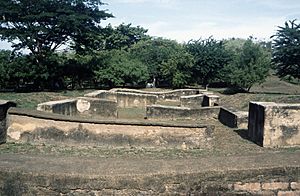León Viejo facts for kids
Quick facts for kids León Viejo |
|
|---|---|

Ruins of León Viejo, 2004
|
|
| Location | Near La Paz Centro |
| Founded | June 15, 1524 |
| Official name: Ruins of León Viejo | |
| Type | Cultural |
| Criteria | (iii)(iv) |
| Designated | 2000 (24th session) |
| Reference no. | 613rev |
| Region | Latin America and the Caribbean |
| Lua error in Module:Location_map at line 420: attempt to index field 'wikibase' (a nil value). | |
Ruins of León Viejo is an amazing World Heritage Site in Nicaragua. It's where the city of León first started! Today, it's a town called Puerto Momotombo, located near La Paz Centro in the León Department. The Nicaraguan Institute of Culture takes care of this important historical place.
León Viejo was founded on June 15, 1524, by a Spanish conquistador named Francisco Hernández de Córdoba. Sadly, he was executed in the town's main square in 1526 by governor Pedrarias Dávila.
When the Spanish settlers arrived, about 15,000 native people already lived there. León Viejo was built on the southwestern banks of Lake Xolotlán (also called Lake Managua), south of the Momotombo volcano. This area often had volcanic activity, leading to big earthquakes in 1594 and 1610.
The city wasn't completely destroyed by the 1610 earthquake. However, the buildings were damaged, and the ground kept shaking. So, the settlers decided to move the city to a new spot. They relocated about 20 kilometers (12 miles) to the west, where the city of León is today. Over time, the old city was slowly buried by ash and volcanic rocks from Momotombo, and by dirt from the lake.
Contents
Discovery and Layout of the Ancient City
The ruins of León Viejo were found in 1967, and digging began the next year. These excavations showed that the city was planned like many other cities in America at that time. It had a grid system of streets with a main square in the middle. León Viejo covers an area of about 800 meters by 500 meters. Around the main square and on the nearby streets, 16 ruined buildings have been partly restored.
The city had three monasteries: "La Merced," "San Pedro," and "San Francisco." These were active until October 1559. The ruins of La Merced and San Pedro have been identified, but they have been damaged by natural disasters over the years. In May 1982, tropical storm Aletta damaged the city's walls. In October 1988, Hurricane Joan caused more damage, and in October 1998, Hurricane Mitch affected about 40% of the site, damaging several houses, the La Merced convent, and La Fortaleza.
León Viejo is special because it's the only 16th-century colonial city in America that has never been changed or rebuilt over its original plan. This was the main reason why UNESCO declared it a World Heritage Site in 2000.
What Archaeologists Found
Archaeologists have done a lot of work at León Viejo to learn about its past. They wanted to understand how the Spanish settlers lived and how they interacted with the native people.
When they dug into the ground, they found many interesting things. These included pieces of pottery, stone tools, metal objects, and even animal and human remains.
Ancient Pottery and Tools
Archaeologists found over 2,200 pieces of pottery. These included different types of ancient pots and bowls, some with special designs or fabric impressions. This pottery helps them understand how people lived and what they used for cooking and daily life.
They also found many stone tools, especially from a material called obsidian. Obsidian is a sharp, glass-like volcanic rock. Many of these tools were thin, sharp blades called "prismatic knives." These knives were very good for cutting and show how skilled the ancient people were. The obsidian came from different places like Guatemala, El Salvador, and Honduras. This tells us that people in León Viejo traded with other towns across Central America.
Other stone tools found included spearheads and arrowheads made from chalcedony, another type of stone. These were likely used for hunting or other specific tasks.
Metal Objects and Animal Remains
Archaeologists also found metal objects, mostly nails and fragments of metal. These likely came from colonial-era buildings or coffins.
They also found many animal remains, including shells from mollusks, fish bones, reptile bones, bird bones, and mammal bones. Even though the amounts were small, these findings give clues about what people ate and what kind of animals lived in the area during ancient times.
Important Discoveries
Based on what they found, archaeologists believe that the Spanish built their city on top of or very close to an existing native settlement. This means the Spanish might have built their churches and main square in places where the native people already gathered.
León Viejo is a unique window into the past. It helps us understand what life was like when the Spanish first arrived in Nicaragua and how their cities were built.
See also
 In Spanish: León Viejo para niños
In Spanish: León Viejo para niños

